, George C. Babis2 and Kalliopi Lampropoulou-Adamidou3
(1)
Orthopaedic Department Medical School, National and Kapodistrian University, Athens, Greece
(2)
2nd Orthopaedic Department Medical School, National and Kapodistrian University Nea Ionia General Hospital “Konstantopoulion”, Athens, Greece
(3)
3rd Orthopaedic Department, National and Kapodistrian University KAT General Hospital, Athens, Greece
Abstract
This chapter refers to the radical improvement of young female patients’ quality of life, born with severe deformities of the hip joint, after total hip replacement. Letters of these patients, many years after surgery, show their satisfaction for the great changes in their physical and psychological status and in their social and family life.
The long-term quality of life (QoL) of young female patients with congenital hip disease (CHD), especially those with low and high dislocation, radically improves after total hip replacement (THR) [1]. Before surgery these patients had severe limping, pain, body deformations in most of them and great leg-length discrepancy. They also had several psychological problems, such as anxiety and depression, even since their early childhood [2–8]. The severe disability had affected their lives in a fundamental way. Having usually experienced multiple and prolonged treatments since early childhood, they describe traumatic memories, especially those in the course of their development years.
The characteristic way these patients describe their mental and physical experiences is reflected in their letters included in our study on the QoL of patients of our registry [1]. This study was performed on 82 female patients, with low dislocation (67 hips) and high dislocation (48 hips), followed for a minimum of 12 years (12–37), and we concluded that THR radically improves QoL of these patients for a long period of time. Even patients who underwent several revisions had enjoyed pain relief and functional improvement for an appreciable period of time.
Representative cases are presented:
Case 1
A 37-year-old female with high dislocation of 7 cm on the left hip and low dislocation on the right (Fig. 11.1). She had no previous treatment. She was born in 1943. She was limping since infancy, but started to have pain in the right hip which had low dislocation, approximately at the age of 25. In 1981, at the age of 40, she had a Charnley low-friction arthroplasty (LFA), initially on the right hip (Fig. 11.2) and 5 months later on the left with cotyloplasty (Fig. 11.3). Preoperatively, right leg-length was 70 cm and the left 65 cm. Postoperatively, the leg-lengths were 72 cm right and 69 cm left. Eight years after surgery both components of the left hip were revised because of loosening (Fig. 11.4). Six years later, the left femur was fractured and the stem was rerevised (Fig. 11.5). The left cup was also rerevised because of wear, 22 years after revision (Fig. 11.6). Right hip was revised because of loosening, 18 years after primary replacement.
In total, this patient had three revisions on the left hip and one on the right (Fig. 11.7). At the latest follow-up examination, 32 years after primary surgery, the patient, at the age of 72, stated that she was partially satisfied from her hip problem. Letter sent:
I was born in a small Greek village during the 2nd World War. My parents, poor and illiterate, had to raise 4 daughters. My mother was treating me badly. She was referring to me as calling me a “crippled” and “half person”. When others were listening, these words were hurting me more. I was ridiculed by the other children in school. When the teacher of gym wanted to put me out not to be tired I was crying.
Since I was 12 years old I started working as a housemaid in several houses. When I started feeling pain, at the age of 25, my life became unbearable. I had to work hard while in pain and great difficulties even getting around. I was 38 when I had my hips operated. The result was outstanding. Pain was gone and stopped feeling useless. For the next 15 years, I was feeling very good, getting around as a normal person. I had no pain and I was barely limping. After that I had undergone three more operations on my left hip and one operation on my right hip.
I am now 72 years old and all I want is a life without pain. I have faith in God and in my surgeon and I believe that everything will go well.
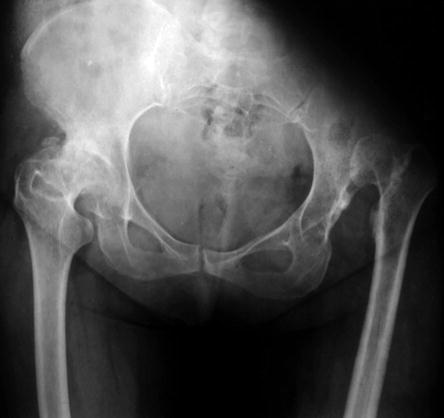
Fig. 11.1
Preoperative radiograph
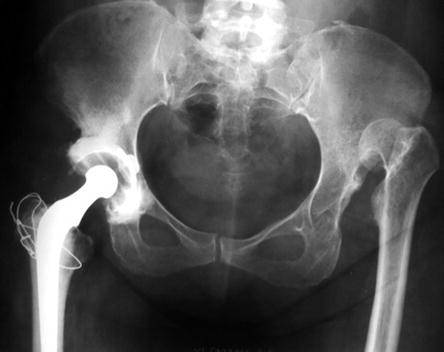
Fig. 11.2
Radiograph after LFA on the right hip
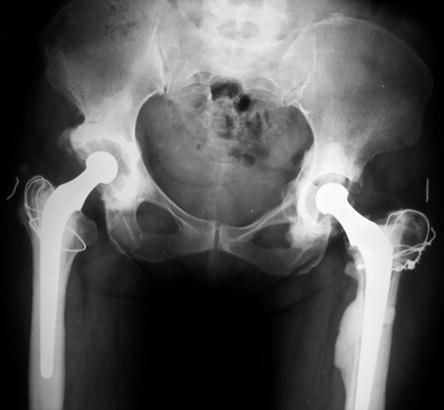
Fig. 11.3
Radiograph taken 5 years after LFA on both hips. Note the escape of cement from the inner cortex of the left femur due to penetration during surgery
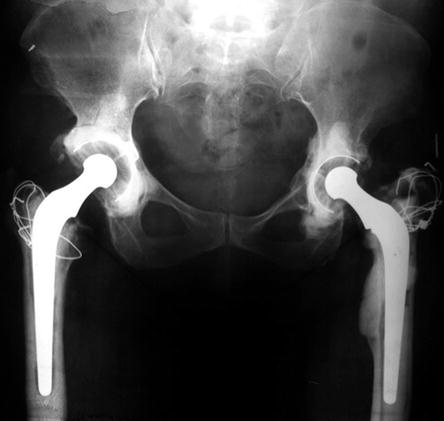
Fig. 11.4
Eight years after primary operations, the left hip needed revision because of loosening
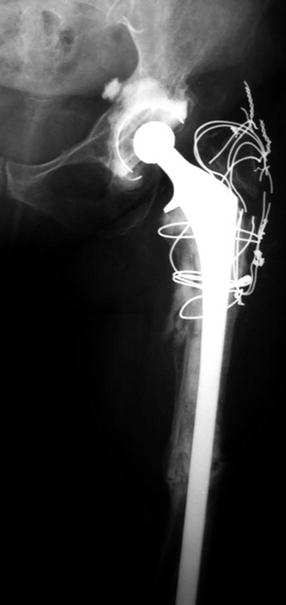
Fig. 11.5
Two years after revision of the left hip, performed because of a periprosthetic fracture of the femur. Abundant wires are due to the failure of removal of the wires used at the primary replacement. Note the union of the fracture at the middle of the femur
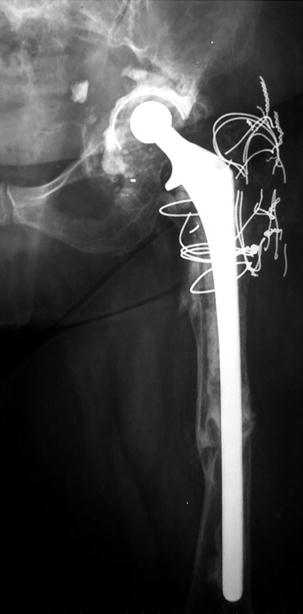
Fig. 11.6
Wear of the polyethylene, severe osteolysis and pelvic dissociation required a rerevision of acetabular component that was performed 22 years after previous revision
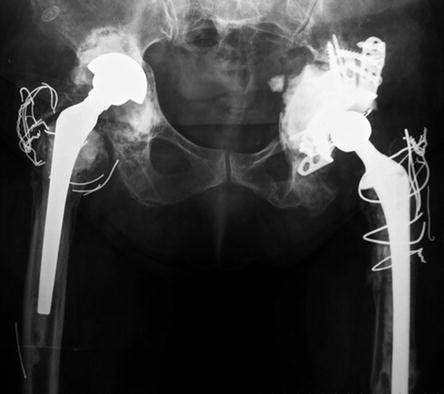
Fig. 11.7
Final radiograph, 32 years after primary THRs. The left hip has been revised three times and the right one
Case 2
This patient with low dislocation of the left hip had a THR at the age of 20, in another institution. Eight years later, revision was needed because of loosening of both components (Fig. 11.8). A LFA with cotyloplasty was used (Fig. 11.9). Since that time (25 years) this patient is symptomless with normal activity (Fig. 11.10). Letter sent:
I was born in a village in Kalavryta. We were a big family (7 children). The parents were illiterate and poor. I was operated at the age of 4. I kept limping. My childhood was a life of torment. My mother was calling me names. She was calling me an invalid, a broken one, a limping creature. She was cursing me many times. She would tell me no man is going to love me. She and my older brother made me feel useless. I had arthroplasty at 20 and a second one at 28. My life changed. I don’t feel useless anymore. My friends tell me that nothing shows when I walk. I met my husband and we were married in 1996. Now we have a 15 year old son and we are a happy family.
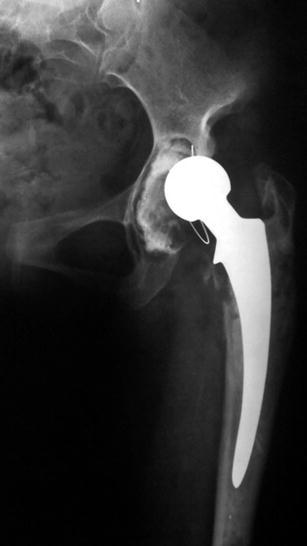
Fig. 11.8
Seven years after cemented, Muller-type THR. The need of revision is obvious
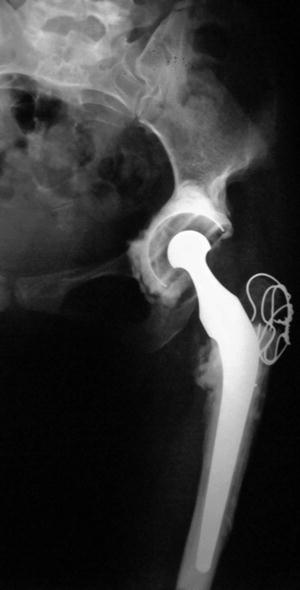
Fig. 11.9
One year after revision with LFA. Note the fibrous union of the trochanter
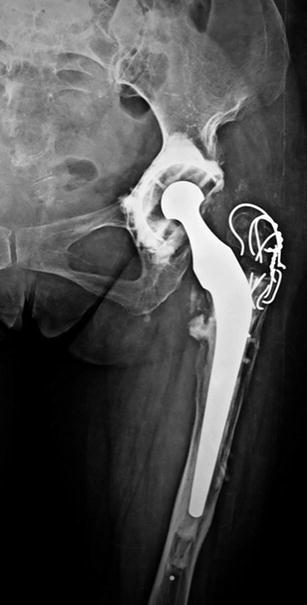
Fig. 11.10
Latest follow-up radiograph, 25 years after revision. Patient remains symptomless without limping
Case 3
This patient was born in 1961 with bilateral CHD. There is no information about the type of conservative treatment she had at the age of 2, followed by an operation on the right hip at the age of 3. She was first seen by us at the age of 26 with low dislocation on the right hip and dysplasia on the left (Fig. 11.11). She had severe pain and limping from the right hip. A Charnley LFA with cotyloplasty was performed on the right hip (Fig. 11.12) and 3 years later a varus osteotomy on the left (Fig. 11.13).
Eleven years after primary replacement, the right acetabular component was revised because of loosening (Fig. 11.14). A new revision of acetabular component was needed after 13 years (Fig. 11.15). Femoral component remains stable for 25 years. Letter sent:
I was born with a dislocation in my right hip. At the age of one and a half they put me in plaster for one year, and later I was operated. I kept limping. My childhood and teenage life were very difficult with many complexities and insecurities. I was feeling like a child of an inferior God. I took the decision to have an arthroplastic surgery at the age of 29. The result was very good. I developed faith for myself and I felt security. I was married and had a boy that became the joy and purpose of my life. Even though in 1994 it was necessary to be operated again, now I am fully active with a normal life. I am very pleased.
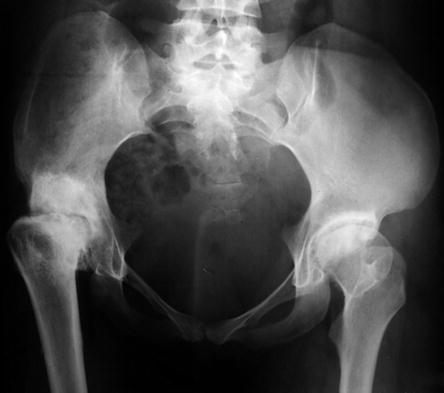
Fig. 11.11
Radiograph at the age of 26
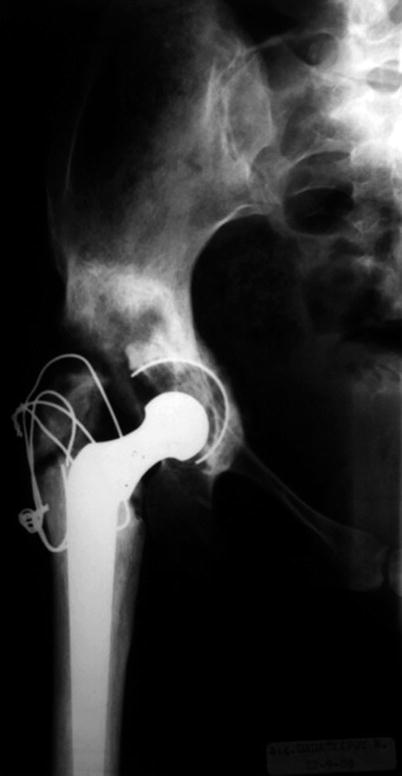
Fig. 11.12
Postoperative radiograph after LFA on the right hip. Fibrous union of the trochanter
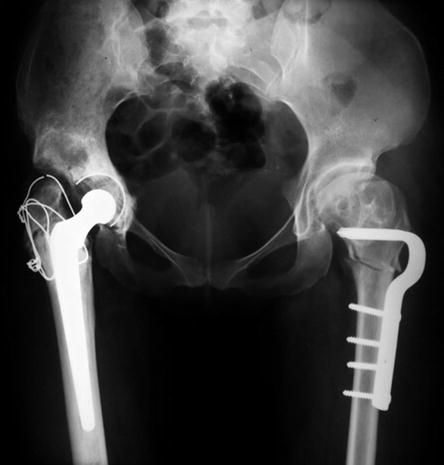
Fig. 11.13
Three years later a varus osteotomy was performed on the left hip
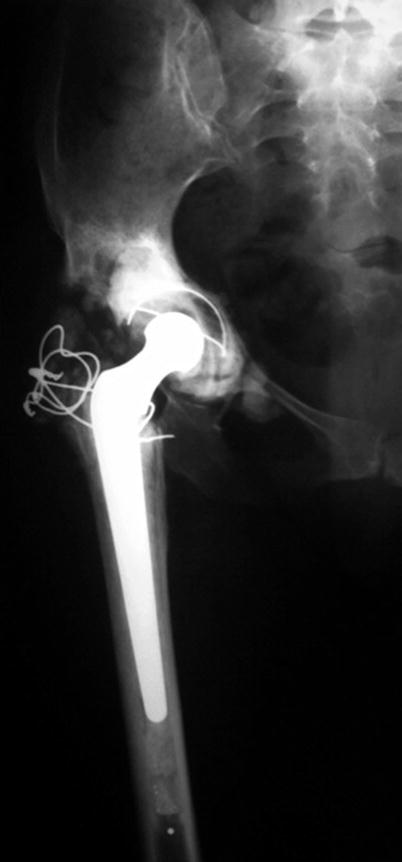
Fig. 11.14
Radiograph after revision of the right acetabular component, 11 years after primary replacement
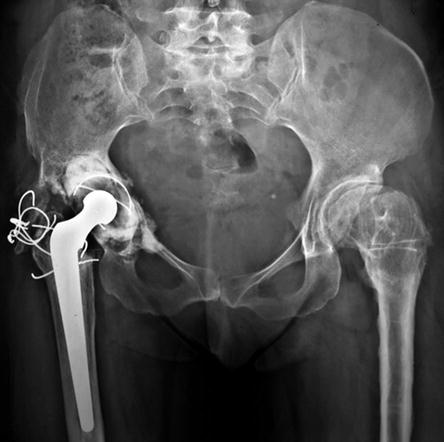
Fig. 11.15
Loosening of the revised acetabular component after 13 years from revision
Case 4
A 46-year-old female with bilateral high dislocation. She was born in 1942. The height of the dislocation was 8 cm in the right and 7 cm in the left hip (Fig. 11.16). She had no previous treatment. She started having pain at the age of 35. The preoperative leg-length was 71 cm right and 70 cm left and the postoperative 75 cm right and 75 cm left.
Stay updated, free articles. Join our Telegram channel

Full access? Get Clinical Tree








